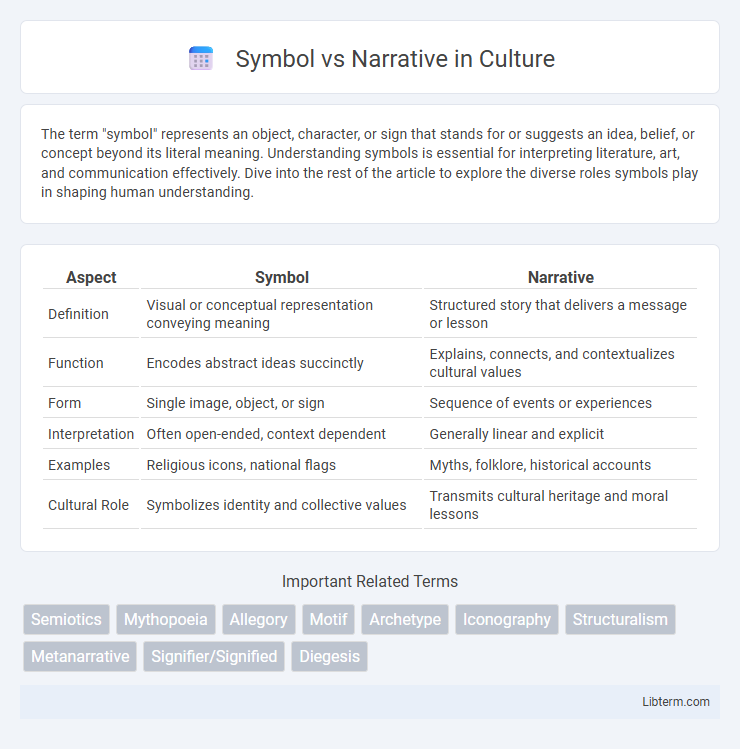The term "symbol" represents an object, character, or sign that stands for or suggests an idea, belief, or concept beyond its literal meaning. Understanding symbols is essential for interpreting literature, art, and communication effectively. Dive into the rest of the article to explore the diverse roles symbols play in shaping human understanding.
Table of Comparison
| Aspect | Symbol | Narrative |
|---|---|---|
| Definition | Visual or conceptual representation conveying meaning | Structured story that delivers a message or lesson |
| Function | Encodes abstract ideas succinctly | Explains, connects, and contextualizes cultural values |
| Form | Single image, object, or sign | Sequence of events or experiences |
| Interpretation | Often open-ended, context dependent | Generally linear and explicit |
| Examples | Religious icons, national flags | Myths, folklore, historical accounts |
| Cultural Role | Symbolizes identity and collective values | Transmits cultural heritage and moral lessons |
Understanding Symbols: Definition and Function
Symbols serve as powerful tools in communication by representing ideas, concepts, or objects beyond their literal meaning, enabling deeper layers of interpretation. Understanding symbols involves recognizing their capacity to evoke emotions, cultural associations, and collective experiences, which shape individual and societal perceptions. These abstract representations function as bridges between the tangible and intangible, facilitating meaning-making in narratives, art, religion, and everyday life.
What is a Narrative? Structure and Purpose
A narrative is a structured account of events or experiences, designed to convey meaning and engage an audience emotionally or intellectually. It typically follows a clear sequence with a beginning, middle, and end, incorporating elements such as characters, setting, conflict, and resolution to build coherence and tension. The purpose of a narrative is to communicate a message, share knowledge, or evoke empathy, often making complex ideas more relatable through storytelling.
Key Differences Between Symbols and Narratives
Symbols are concise visual or textual representations that convey complex ideas or emotions through imagery, while narratives consist of structured sequences of events that develop characters, settings, and plots to communicate a broader story. Symbols evoke meanings instantly and are often open to interpretation, whereas narratives provide context and depth through detailed exposition and progression over time. The primary difference lies in symbols' abstract, standalone significance versus narratives' comprehensive, temporal storytelling approach.
The Role of Symbols in Storytelling
Symbols function as powerful tools in storytelling by encapsulating complex ideas, emotions, and themes within recognizable visuals or motifs. They enhance narrative depth by enabling audiences to connect abstract concepts with concrete images, enriching interpretation and emotional engagement. Effective use of symbols creates layered meanings that resonate across different cultural and temporal contexts, strengthening the impact of the story.
How Narratives Shape Meaning
Narratives shape meaning by linking events, symbols, and characters into coherent stories that evoke emotions and cultural significance. They provide context that transforms abstract symbols into relatable experiences, allowing individuals to interpret and internalize complex ideas. Through storytelling, narratives embed values and perspectives, influencing how societies understand identity, history, and morality.
Interplay Between Symbol and Narrative
The interplay between symbol and narrative enhances storytelling by embedding deeper meanings within symbols that evolve throughout the plot. Symbols act as tangible representations of abstract themes, allowing narratives to convey complex ideas subtly and powerfully. This dynamic fusion enriches audience engagement by inviting interpretation and emotional resonance beyond the literal storyline.
Symbolism in Visual and Literary Arts
Symbolism in visual and literary arts serves as a powerful tool to convey complex ideas and emotions beyond literal interpretation. Visual symbols like color, shape, and iconography evoke cultural and psychological associations that enrich the viewer's understanding. Literary symbols such as metaphors, motifs, and allegories create layers of meaning that deepen narrative resonance and thematic exploration.
Narrative Techniques Across Mediums
Narrative techniques across mediums leverage different tools to shape storytelling, where symbols function as powerful motifs that convey deeper meanings and emotions without explicit explanation. In literature, symbolism enriches themes through metaphorical language, while in film and visual arts, symbols are embedded in imagery, color schemes, and mise-en-scene to evoke subconscious responses. Interactive media incorporates symbolic elements through gameplay mechanics and environmental storytelling, allowing audiences to engage with narratives in personalized and immersive ways.
Cultural Impact: Symbols vs. Narratives
Symbols encapsulate complex cultural values in concise, easily recognizable forms that foster collective identity and social cohesion across generations. Narratives, through detailed storytelling, provide context and emotional depth, shaping cultural beliefs and guiding behavior by conveying shared experiences and moral lessons. Together, symbols and narratives synergistically reinforce cultural norms and inspire communal participation by connecting individuals to larger societal meanings.
Choosing Between Symbol and Narrative in Communication
Choosing between symbol and narrative in communication depends on the message's complexity and emotional impact. Symbols convey ideas quickly and universalize meaning through visual or conceptual shorthand, ideal for branding and instant recognition. Narratives engage audiences by unfolding stories that build context, foster emotional connections, and encourage deeper understanding over time.
Symbol Infographic

 libterm.com
libterm.com